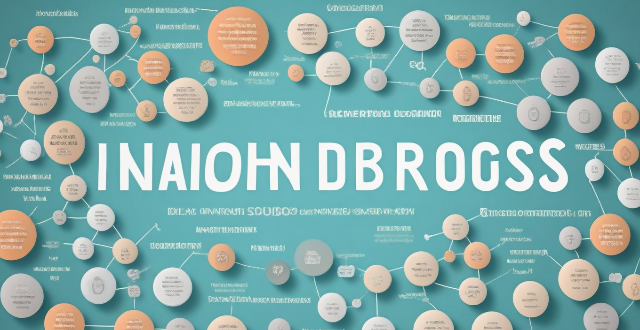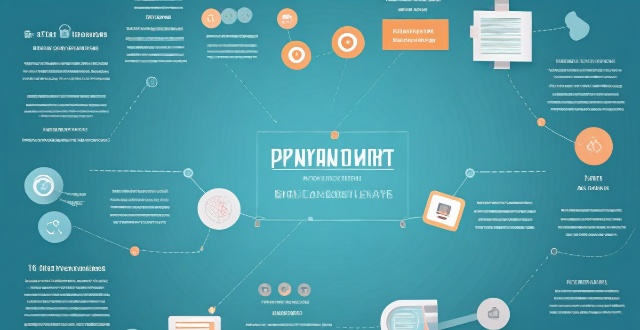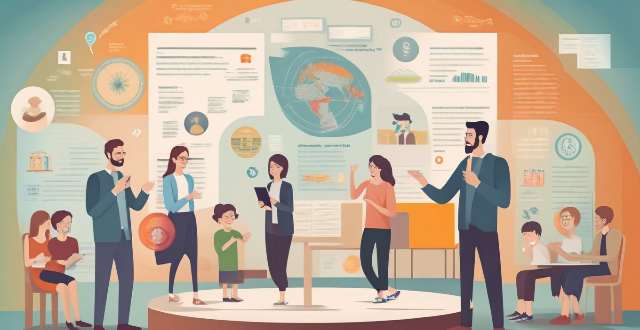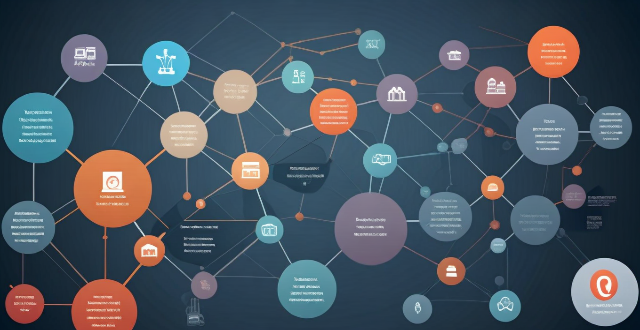Communication Pandemic

What are some best practices for managing a pandemic ?
Managing a pandemic requires a comprehensive approach involving preparedness, communication, and public health measures. Best practices include developing a response plan, stockpiling essential supplies, training personnel, transparent communication, collaboration with health authorities, addressing misinformation, promoting hygiene, implementing social distancing, and encouraging vaccination and testing. By following these practices, communities can better protect their residents and minimize the impact of the pandemic.

How can we balance public health concerns with economic recovery during pandemic management ?
Balancing public health concerns with economic recovery during pandemic management involves implementing widespread testing, efficient contact tracing programs, vaccination campaigns, and clear public health messaging. It also requires targeted restrictions, financial aid, adaptive workplaces, infrastructure investments, and building consumer confidence. Long-term planning includes strengthening health systems, fostering economic diversification, investing in research and innovation, and creating emergency funds. Collaborative governance through intersectoral collaboration, global cooperation, and stakeholder engagement is essential for navigating the dual challenge of protecting public health while fostering economic stability and growth during a pandemic.

What is the current status of the COVID-19 pandemic ?
The COVID-19 pandemic, caused by the novel coronavirus SARS-CoV-2, has significantly impacted the world since its emergence in late 2019. As of September 2023, there have been over 600 million confirmed cases and more than 6 million deaths globally. Many developed countries have high vaccination rates, with over 70% of their populations fully vaccinated, while some developing countries still struggle with access to vaccines. The Omicron variant, first identified in November 2021, has become the dominant strain worldwide due to its high transmissibility. Several subvariants of Omicron, such as BA.4 and BA.5, have emerged, showing increased infectiousness and potential for immune escape. Regional differences exist in terms of vaccination rates, public health measures, and economic impact. Ensuring equitable distribution of vaccines remains a challenge, particularly in low-income countries. The need for booster shots adds complexity to global vaccination efforts. Some countries still enforce mask mandates in certain settings, while others have lifted these requirements. Testing protocols vary widely. Many countries are focusing on economic recovery while managing the ongoing pandemic threat. The shift to remote work has had both positive and negative impacts on various industries and job markets. Looking forward, some experts discuss reaching herd immunity through vaccination and natural infection, while there is an increased focus on improving pandemic preparedness for future outbreaks. The mental health toll of the pandemic is becoming more apparent, with increased rates of anxiety and depression. School closures have led to learning losses, particularly among disadvantaged students.

How has the COVID-19 pandemic highlighted the importance of financial literacy ?
The COVID-19 pandemic has underscored the importance of financial literacy. It helps people navigate job losses, market volatility, personal finance management, long-term planning, and healthcare needs. Financially literate individuals are better equipped to handle economic disruptions and make informed decisions about their money. Seeking support and resources is also crucial during challenging times. Overall, financial literacy is essential for personal resilience and economic stability in the face of global crises like the pandemic.

What is social distancing and why is it important during a pandemic ?
Social distancing is a crucial measure in pandemic control. It involves maintaining physical distance between people to reduce the spread of infectious diseases. The importance of social distancing during a pandemic includes reducing transmission rates, protecting vulnerable populations, allowing health systems to cope, and facilitating other public health measures. To effectively implement social distancing, governments and health organizations often recommend or mandate measures such as stay at home orders, remote work, closure of non-essential businesses, cancellation of events, and public awareness campaigns. Adhering to social distancing guidelines becomes a community effort towards a safer and healthier environment for all.

Is there a standard guideline for wearing PPE during COVID-19 pandemic ?
The text provides a summary of the standard guidelines for wearing Personal Protective Equipment (PPE) during the COVID-19 pandemic. The guidelines are designed to protect healthcare workers, first responders, and other essential workers from getting infected with the virus. The levels of PPE required vary depending on the level of risk involved in different situations, ranging from low risk to high risk. The text also provides best practices for wearing PPE, including hand hygiene, putting on and removing PPE in the correct order, and proper disposal of PPE items.

How effective has the government's pandemic management been so far ?
The effectiveness of the government's pandemic management can be evaluated based on several key factors, including the speed and scope of response, coordination of resources, implementation of public health measures, and communication and transparency with the public. In terms of speed and scope of response, the government's initial response to the pandemic was crucial in determining the overall effectiveness of its management. This includes the timeliness of declaring a state of emergency, implementing travel restrictions, and establishing testing protocols. The allocation of resources such as medical supplies, hospital beds, and personnel was another important factor. The government needed to ensure that these resources were distributed efficiently and equitably across affected areas. As the pandemic progressed, the ability to scale up response efforts, such as increasing testing capacity and contact tracing, was essential for containing the spread of the virus. Effective coordination between different government agencies and departments was vital for a unified and cohesive response. This involved collaboration between health, transportation, education, and other relevant sectors. Partnering with private companies and organizations could help in leveraging their expertise and resources, such as utilizing technology for contact tracing or collaborating with pharmaceutical companies for vaccine development. Working closely with international partners and sharing information and resources could enhance the overall response effort and contribute to global pandemic control. The implementation of public health measures played a significant role in mitigating the spread of the virus. Testing strategies and contact tracing programs were critical for identifying cases and preventing further transmission. The rollout of vaccination programs was essential for achieving herd immunity and reducing the impact of the pandemic. The government needed to ensure equitable access to vaccines and efficient distribution mechanisms. Encouraging public compliance with health guidelines, such as mask-wearing and social distancing, through effective communication campaigns was also crucial for mitigating the spread of the virus. Communication and transparency were key factors in maintaining public trust and awareness during the pandemic. Providing regular updates on the pandemic situation, including case numbers, hospitalization rates, and mortality rates, helped maintain public trust and awareness. Basing decisions on scientific evidence and expert advice demonstrated a commitment to evidence-based policymaking, which is crucial for an effective response. Being transparent about challenges faced during the pandemic, such as supply shortages or delays in vaccine delivery, fostered trust and understanding among the public. In conclusion, evaluating the effectiveness of the government's pandemic management requires a comprehensive assessment of various factors, including the speed and scope of response, coordination of resources, implementation of public health measures, and communication and transparency with the public. By considering these aspects, we can gain a better understanding of how well the government has managed the pandemic so far.

How have businesses adapted to pandemic management measures ?
Businesses worldwide have undergone significant transformations in response to the COVID-19 pandemic, including increased adoption of remote work, changes in operations like local sourcing and automation, health and safety measures such as physical distancing and PPE, financial strategies including cost cutting and government aid, enhanced communication and marketing efforts through virtual events and content marketing, and rapid digital transformation with cloud services and data analytics. These adaptations aim to ensure business survival and operation during these challenging times while also presenting opportunities for future growth and efficiency.

What lessons can we learn from previous pandemics to improve our current response efforts ?
The text discusses lessons learned from previous pandemics, emphasizing the importance of early detection and response, global cooperation and information sharing, robust public health infrastructure, reliance on science and evidence-based policymaking, and addressing socioeconomic factors that influence pandemic outcomes. Examples from past pandemics such as HIV/AIDS, H1N1, and COVID-19 illustrate these points, highlighting the need for a comprehensive approach to future pandemic responses.

What are the common causes of communication interference ?
Communication interference can occur due to physical barriers like noise and technology issues, language differences, cultural norms, emotional factors, personal biases, misunderstandings, lack of active listening, and poor message construction. Being aware of these causes can help individuals improve their communication skills and minimize disruptions in various contexts.

How has the COVID-19 pandemic affected ESG priorities for businesses ?
The COVID-19 pandemic has significantly impacted businesses worldwide, affecting their operations, financial performance, and strategic priorities, particularly in the area of Environmental, Social, and Governance (ESG) priorities. The pandemic has led to an increased focus on sustainability, a shift towards remote work, health and safety concerns, mental health support, transparency and accountability, and stakeholder engagement. To address these challenges, businesses should conduct a comprehensive ESG assessment, develop a sustainability strategy, implement health and safety measures, offer mental health support, increase transparency and accountability, and engage with stakeholders. By taking proactive steps to address these challenges, businesses can improve their ESG performance and build resilience and adaptability in the face of future crises.

How do communication satellites support military operations and intelligence gathering ?
This text discusses how communication satellites support military operations and intelligence gathering, highlighting their role in secure communication channels, wide area coverage, high-speed data transmission, surveillance and reconnaissance, coordination and command, resilience and redundancy.

How has the COVID-19 pandemic affected issues of academic integrity, especially with online learning ?
The COVID-19 pandemic has significantly impacted academic integrity in the education sector, particularly due to the shift to online learning. The increased opportunities for cheating during online examinations and plagiarism are major concerns. Difficulty in maintaining academic integrity standards, potential for misunderstandings and miscommunications, and strategies to address these challenges are also discussed.

Can solar flares cause communication interference ?
Solar flares, intense bursts of radiation from the sun's atmosphere, can disrupt communication systems on Earth. This includes shortwave radio signals, satellite communications, and other terrestrial networks. The effects range from signal quality disruption and frequency deviation to satellite link disruptions, GPS accuracy issues, and even physical damage to satellite hardware. While these impacts vary, organizations involved in critical communication operations must be aware of the risks and implement mitigation strategies to minimize potential disruptions.

How does satellite communication compare to other forms of communication ?
Satellite communication offers global coverage, high capacitySatellite communication offers global coverage, high capacity higher latency and initial costs and reliability but has higher latency and initial costs compared to terrestrial and wireless communication. Terrestrial communication provides lower latency and moderate reliability at a lower cost, while wireless communication offers convenience and portability at a variable cost. Satellite communication is suitable for remote areas and sensitive applications due to its security features.

What are the benefits and drawbacks of using visual aids in climate science communication ?
Visual aids in climate science communication can enhance comprehension, engagement, and universal appeal but may oversimplify data or mislead if not accurately designed. Creators must balance benefits and drawbacks for effective communication.

How can we prevent communication interference during critical missions ?
To prevent communication interference during critical missions, organizations should use reliable communication systems, minimize environmental factors, train personnel adequately, test equipment beforehand, and use clear and concise language. These strategies can help ensure successful completion of missions by minimizing the risk of communication disruptions.

What role does communication play in women's relationship management ?
The article discusses the crucial role of communication in women's relationship management, highlighting its importance in building trust, understanding, empathy, and intimacy. It also provides tips for effective communication, such as active listening, non-verbal cues, I-messages, choosing the right time and place for conversations, and compromising and collaborating. By employing these strategies, women can navigate conflicts and challenges in their relationships effectively.

How has the COVID-19 pandemic highlighted the importance of resilient supply chain management in the face of climate-related disruptions ?
The text discusses the impact of the COVID-19 pandemic on supply chain management and emphasizes the importance of resilient supply chain management to withstand future climate-related disruptions. The pandemic caused significant disruptions in the global supply chain, including disruption of global trade, bottlenecks, shortage of raw materials, and labor shortages. A resilient supply chain is adaptable, diversified, collaborative, and leverages technology to improve efficiency, reduce waste, and increase transparency. These characteristics ensure that the supply chain can withstand not only the current crisis but also future climate-related disruptions.

How has the pandemic impacted the energy market ?
The COVID-19 pandemic has significantly impacted the energy market by decreasing demand, causing price fluctuations, and accelerating the shift towards renewable energy sources. With businesses and schools closed, people staying home more often, and reduced commuting and travel, there has been less need for energy consumption, leading to a reduction in electricity usage during peak hours. Industrial sources have seen lower energy consumption due to factory shutdowns or reduced production, while transportation sectors have experienced decreased demand for gasoline, diesel fuel, and jet fuel. Residential energy demand has also decreased as people adopted more energy-efficient habits. Energy prices have fluctuated, particularly in the oil and gas industry, with crude oil prices falling sharply at the beginning of the pandemic but recovering somewhat since then. Natural gas prices have also experienced volatility due to declines in demand. However, as economies begin to recover and restrictions ease, energy prices may increase again. The pandemic has accelerated the transition towards renewable energy sources as governments and businesses seek to reduce their carbon footprint and mitigate climate change. Governments have implemented policies aimed at promoting renewable energy development, such as tax incentives for solar and wind projects or bans on new fossil fuel infrastructure. Companies across various industries have set ambitious sustainability goals, including reducing their greenhouse gas emissions and increasing their use of renewable energy sources. This trend is expected to drive further growth in the renewable energy sector even after the pandemic subsides.

How does altitude affect communication interference ?
This article discusses how altitude affects communication interference in wireless communication. It explains the various ways that altitude can impact signal strength, including signal attenuation, refraction and scattering, ionospheric effects, and multipath propagation. The article also provides tips for mitigating these effects, such as increasing transmitter power, using higher frequencies, implementing error correction techniques, using directional antennas, and choosing suitable locations for equipment. Overall, understanding altitude's impact on communication interference is crucial for ensuring effective communication in wireless systems.

How has the COVID-19 pandemic affected global health ?
The COVID-19 pandemic has significantly impacted global health by increasing infection and mortality rates, straining healthcare systems, causing mental health concerns, affecting healthcare economics, prompting public health policies and responses, and potentially causing long-term effects.

What are the challenges faced in satellite communication ?
Satellite communication faces challenges such as atmospheric effects, physical obstructions, technical limitations, economic factors, regulatory issues, environmental impacts, security concerns, geopolitical factors, technological advancements, and natural disasters. These challenges highlight the need for innovation and improvement in maintaining reliable satellite communication networks.

How does cultural diversity affect communication within a workplace ?
Cultural diversity has a profound impact on workplace communication, presenting both challenges and benefits. Challenges include misunderstandings due to language barriers and differences in non-verbal cues, variations in communication styles, and differing norms and expectations. Benefits encompass enhanced creativity, improved problem-solving, and greater empathy. Strategies for promoting effective communication involve education and training, clear messaging, open dialogue, and celebrating diversity. By addressing challenges and leveraging benefits, organizations can build cohesive teams that thrive on their collective differences.

What is the impact of communication interference on military operations ?
The text discusses the impact of communication interference on military operations. It highlights five main consequences: loss of situational awareness, delayed response times, compromised security, reduced coordination, and increased risk of misinterpretation. The author emphasizes the importance of secure and reliable communication systems for effective military strategy and suggests developing contingency plans to mitigate the risks associated with communication interference.

How does the pandemic affect the performance of tech stocks ?
The COVID-19 pandemic has significantly impacted tech stock performance through increased demand for technology, supply chain disruptions, changes in investor sentiment, and government stimulus and regulation. Remote work and learning have boosted tech sales, while e-commerce growth has further driven revenue. However, production delays and component shortages pose challenges. Investor behavior varies, with some seeking safety in tech stocks and others avoiding risk. Government support and regulatory changes also influence the sector's performance. The long-term effects on tech stocks remain uncertain.

How has the COVID-19 pandemic affected the global economy ?
The COVID-19 pandemic has caused a slowdown in production, reduced consumer spending, job losses, disruption of global supply chains, financial market volatility, and required government intervention with stimulus packages.

What role do healthcare workers play in effective pandemic management ?
The role of healthcare workers in effective pandemic management includes diagnosis and treatment, prevention and control measures, contact tracing and testing, vaccination programs, mental health support, and collaboration with other healthcare professionals. Their expertise and dedication are crucial in reducing the spread of the virus and improving patient outcomes.

What is the role of cybersecurity in protecting communication systems ?
The text discusses the importance of cybersecurity in protecting communication systems by ensuring data confidentiality, integrity, and availability. It outlines measures such as encryption techniques, access control, digital signatures, hash functions, network uptime, redundancy, and disaster recovery plans. Additionally, it suggests best practices like regular updates, firewalls, user awareness training, strong authentication mechanisms, and incident response plans to enhance cybersecurity in communication systems.

How have communication protocols evolved over time ?
The evolution of communication protocols has significantly impacted modern communication systems, transitioning from simple analog signals to complex digital networks. Early communication systems were limited in speed and reliability, but laid the foundation for future advancements. The digital revolution introduced packet switching, leading to protocols like X.25 and Frame Relay. The Internet Protocol Suite (TCP/IP) standardized communication over the internet, enabling global connectivity and applications like email and web browsing. Wireless protocols like Wi-Fi and Bluetooth allowed mobile devices to communicate without physical connections. Future developments may include 5G networks, quantum communication, and IoT protocols. Overall, the evolution of communication protocols has greatly enhanced our ability to connect and access information.